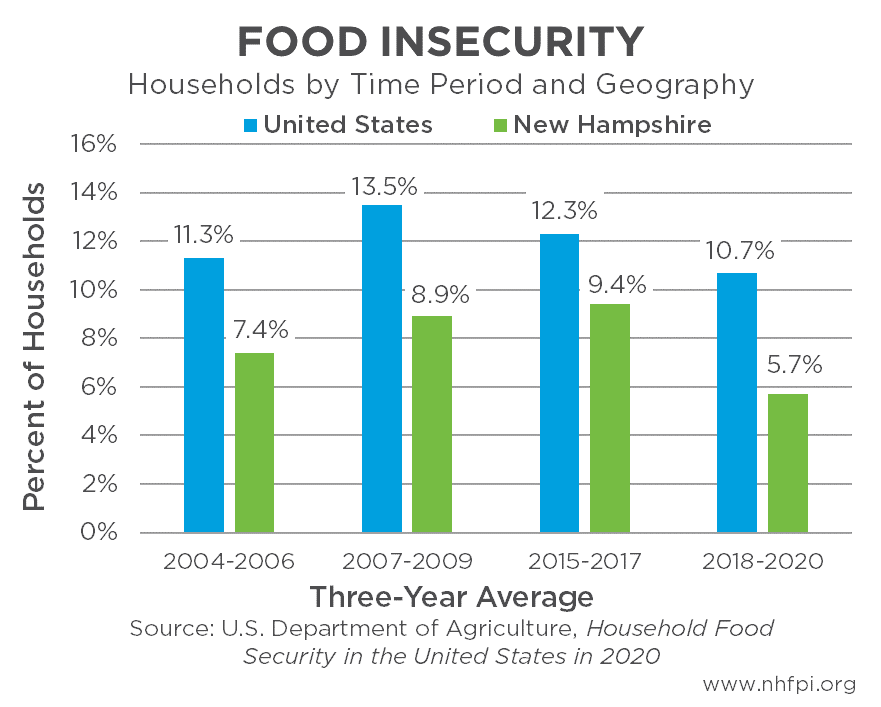Data released on September 8 by the United States Department of Agriculture (USDA) provide updated estimates of levels of food insecurity across the United States and in New Hampshire. These estimates show that levels of food insecurity in 2020 did not increase overall when compared to prior periods despite the pandemic. The economic challenges that faced Granite Staters throughout 2020 were severe, yet these recent data indicate the positive impacts that key policy actions had on mitigating a larger expected rise in food insecurity.
Food Insecurity Levels in New Hampshire and the Nation
This recently released USDA report compiles and analyzes the most recent data gathered by the U.S. Census Bureau Current Population Survey Food Security Supplement, which was collected in December 2020. The questionnaire is distributed to a representative sample of households throughout the country in order to gather key information about food access and nutrition, and estimate food security at the national and state level. The USDA is responsible for measuring food insecurity and administering key nutritional aid programs, including the Supplemental Nutrition Assistance Program (SNAP) in tandem with states. According to the USDA, food insecurity means that “households were, at times, unable to acquire adequate food for one or more household members because they had insufficient money and other resources for food”, at some point in the last year. Nationally, an estimated 10.5 percent of households across the United States were food insecure at some point during 2020. These national estimates show that food insecurity was more prevalent among households with children, with even higher levels experienced by households with young children under the age of six years and households headed by single adults. Additionally, these national data show food insecurity levels were significantly higher for households headed by an individual identifying as Black or Hispanic and for households with lower incomes living at or near poverty. Notably, food insecurity faced by households with children may have increased slightly in 2020, compared to 2019, despite overall national levels of food insecurity decreasing.
Three years of survey data are combined to calculate the state level estimates, due to smaller sample sizes and the need to collect sufficient information to reliably estimate the percentage of households that are food insecure. This three-year time span is necessary to provide adequate data for meaningful analysis, which is particularly important for smaller population states like New Hampshire. In New Hampshire, 5.7 percent of households were estimated to be food insecure during the 2018-2020 period. This represents about 31,000 households where food insecurity was reported at least once in the past year. This estimated level of food insecurity represents a statistically significant decline when compared to the 2015-2017 period that occurred fully before the most recent data, indicating that policy actions to respond to the pandemic mitigated potential increases in food insecurity during the pandemic. Additionally, the 2007-2009 period, which includes the Great Recession, resulted in higher levels of food insecurity than estimated during the COVID-19 crisis. The Great Recession prompted fewer overall employment income losses, but the policy responses to the COVID-19 crisis throughout 2020 were more expansive than those implemented during the recovery from the Great Recession in providing direct support to individuals and families impacted.
Policy Responses to the COVID-19 Crisis Boosted Access to Food
The COVID-19 pandemic resulted in significant and uneven employment impacts throughout 2020 in New Hampshire. Since April 2020, the U.S. Census Bureau’s Household Pulse Survey has been collecting regular survey data to understand the impacts of the pandemic on households, including estimates of food scarcity, which is when individuals in a household sometimes or often lack enough to eat in the last seven days. This metric has a smaller scope than the definition of food insecurity, but suggested that between April and December 2020, between 4 percent and 12 percent of households in the state had some challenges in accessing food. Key policy changes in response the economic challenges facing Granite Staters included direct aid to individuals and families, boosted SNAP benefits, and extended access to unemployment supports, among other key programs.
The recently released USDA report showing declining estimated overall food insecurity levels during 2020 may indicate that these pandemic-related support and relief programs aided in mitigating increases of food insecurity in both New Hampshire and the nation. As the recovery from the COVID-19 crisis continues, nutritional aid programs will provide needed assistance to Granite Staters who are struggling to afford sufficient food. In addition, programs like SNAP stimulate the economy, aiding in the overall ongoing economic recovery. Continuing to help ensure that individuals and families in need receive assistance may help promote a more equitable and inclusive recovery and may aid in continuing to reduce levels of food insecurity.
– Michael Polizzotti, Policy Analyst
Revision, October 21, 2021:
The 2018-2020 food insecurity level in the United States shown in the graph been revised from 10.5% to 10.7% to correct an earlier error.

